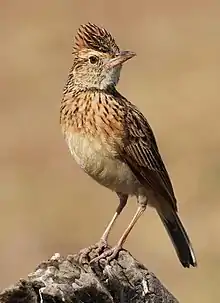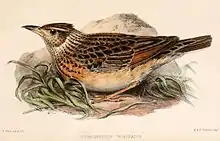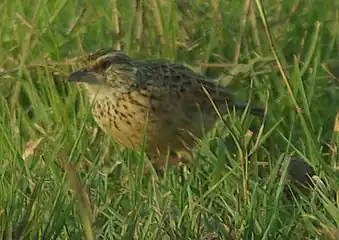Rufous-naped lark
The rufous-naped lark (Mirafra africana) or rufous-naped bush lark is a widespread and conspicuous species of lark in the lightly wooded grasslands, open savannas and farmlands of the Afrotropics. Males attract attention to themselves by a bold and often repeated wing-fluttering display from a prominent perch, which is accompanied by a melodious and far-carrying whistled phrase.[2] This rudimentary display has been proposed as the precursor to the wing-clapping displays of other bush lark species.[3] They have consistently rufous outer wings and a short erectile crest,[2] but the remaining plumage hues and markings are individually and geographically variable. It has a straight lower, and longish, curved upper mandible.
| Rufous-naped lark | |
|---|---|
 | |
| Adult male M. a. transvaalensis | |
| Song recorded in Kiboko, Kenya | |
| Scientific classification | |
| Domain: | Eukaryota |
| Kingdom: | Animalia |
| Phylum: | Chordata |
| Clade: | Dinosauria |
| Class: | Aves |
| Order: | Passeriformes |
| Family: | Alaudidae |
| Genus: | Mirafra |
| Species: | M. africana |
| Binomial name | |
| Mirafra africana Smith, 1836 | |
| Subspecies | |
|
23, see text | |
 | |
| resident range | |
.jpg.webp)


Taxonomy and systematics
The rufous-naped lark is geographically very variable,[4] and is taken to form a species complex with the allopatric[5] red-winged lark of East Africa, and perhaps with the Somali lark. It is a smaller version of the first, with a finer bill and shorter tail,[6] but their morphological and vocal features do not intergrade where their ranges meet.[7] The rufous nape is an equivocal field character, being absent in the tropical races[8] and in some individuals.
Due to the inherent variability of the species, some of the 23–25 odd races are perhaps insufficiently distinct or clinal. Consequently, M. a. rostrata and M. a. zuluensis are sometimes merged with M. a. africana, and M. a. okahandjae with M. a. pallida.[9] On the other hand, a few taxa are arguably incipient or full species. The distinctly plumaged blackish lark comprises races M. a. nyikae and M. a. nigrescens, and is altitudinally isolated from M. a. transvaalensis in nearby Tanzania.[5] Malbrant's lark, M. (a.) malbranti, which ranges from Gabon to Angola, has a fairly distinct display flight, but may intergrade with M. a. kabalii in Zambia.[6]
Sharpe's lark, M. (a.) sharpii, of northwestern Somalia, has almost plain, coppery red upper parts[10] and is sometimes (e.g., by Sibley and Monroe) regarded as a separate and endangered species. Its small range of some 21,200 km2 is impacted by overgrazing and conversion to croplands.[11][12] It may however be conspecific with Somali lark, M. (a.) somalica,[12] which differs by its very long bill and white edges to the outer tail feathers.[10] The Somali lark is sometimes considered a race of rufous-naped lark, but is alternatively deemed a full species in Mirafra or Certhilauda.[6]
Subspecies
Twenty-two subspecies are recognized:[13]
- M. a. henrici Bates, 1930 is found from Guinea to south-western Ivory Coast.
- M. a. batesi Bannerman, 1923 was originally described as a separate species. It is found from central Nigeria to south-eastern Niger and western Chad.
- M. a. stresemanni Bannerman, 1923, the "Cameroon rufous-naped lark", was originally described as a separate species. It is found in north-central Cameroon.
- M. a. bamendae Serle, 1959 is found in western Cameroon.
- M. a. kurrae Lynes, 1923, the "Darfur rufous-naped lark", is found in western Sudan.
- M. a. tropicalis Hartert, 1900, the "Uganda rufous-naped lark", is found from eastern Uganda and western Kenya to north-western TanzaniaM. (a.) somalica. It was originally described as a separate species, and is found in north-western Somalia.[14] Clements split this subspecies into a distinct species.
- M. a. ruwenzoria Kinnear, 1921, the "Rwenzori rufous-naped lark", is found from the DRC to south-western Uganda.
- M. a. athi Hartert, 1900, the "Athi rufous-naped lark", is found from central Kenya to north-eastern Tanzania.
- M. a. harterti Neumann, 1908, the "Ukamba rufous-naped lark", is also known as "Kikuyu rufous-naped lark". It is found in south-central Kenya.
- M. a. malbranti Chapin, 1946, or "Malbrant's lark", was originally described as a separate species. It is found from Gabon to central Angola and the southern DRC.
- M. a. chapini Grant, CHB & Mackworth-Praed, 1939 is found in south-eastern DRC and north-western Zambia.
- M. a. occidentalis (Hartlaub, 1857), the "Gabon rufous-naped lark", is found in western Angola.
- M. a. kabalii White, CMN, 1943 is found in north-eastern Angola and north-western Zambia.
- M. a. gomesi White, CMN, 1944 is found in eastern Angola and western Zambia.
- M. a. grisescens Sharpe, 1902, the "Matabele rufous-naped lark", was originally described as a separate species. Found in western Zambia, northern Botswana and north-western Zimbabwe.
- M. a. pallida Sharpe, 1902, the "Damara rufous-naped lark", was originally described as a separate species. It is found in south-western Angola and north-western Namibia.
- M. a. ghansiensis (Roberts, 1932) is found in eastern Namibia and western Botswana.
- M. a. nigrescens Reichenow, 1900, the "Ukinga rufous-naped lark", was originally described as a separate species. It is found in north-eastern Zambia and southern Tanzania.
- M. a. isolata Clancey, 1956 is found in south-eastern Malawi.
- M. a. nyikae Benson, 1939 is found in eastern Zambia, northern Malawi and south-western Tanzania.
- M. a. transvaalensis Hartert, 1900, the "Transvaal rufous-naped lark", is found from Tanzania to northern South Africa.
- M. a. africana Smith, 1836 is found in south-eastern South Africa.
Description
The rufous-naped lark is a fairly large and robust lark species,[3] with rather heavy flight.[15] The sexes are similar, but males average larger and heavier.[10] Adults are individually[16][17] and geographically variable.[7] It measures 15–18 cm from bill tip to tail tip[16] and weighs 40-44 g.[3][18] The streaked upper parts, short erectile crest, creamy-buff eyebrow that merges with the lore, and the rufous flight feathers are easily discernible features.[3] The hindcrown and nape are streaked along the feather centers[10] while the margins vary from chestnut, rufous or pinkish buff to greyish brown.[3][17] The wings appear conspicuously rufous in flight, while the outer edges of the primaries show up as a rufous panel on the closed wing.[16] The underwing coverts are rufous, and upper coverts are broadly edged tawny or buff (or grey in race grisescens).[17] The tail is dark brown, but the outer webs of the outer tail feathers vary from buff (cf. africana[10] and sharpii[6]) to tawny or bright rufous.[16] The mantle is lighter brown than the back, and the rump still darker brown.[3] The flanks are a shade darker than the rufous-buff belly,[10] but regionally the plumage may also be stained red by soil.[17] The throat is unmarked but the pale rufous upper breast is streaked and spotted darker brown.[3][16] The eyes are hazel brown, the longish bill is blackish and pinkish, and the feet pink to pinkish brown.[3] Juveniles have bold black spotting on the crown, mantle and wing coverts, all edged with buff, while the breast spotting is more blotchy or diffuse.[16][2]
Geographic variation
M. a. athi of the Kenyan highlands is typically coloured,[8] but like other tropical races, lacks the rufous nape.[6] Most accepted races are distinguished based on the colour of the back or underpart plumage, or the amount of streaking on the ear coverts and flanks. High altitude races M. a. nyikae and M. a. nigrescens, which occur above 2,000 meters, have very dark upper part plumages and increased flank streaking.[8] M. a. tropicalis which is found above 1,000 meters has a solid rufous wash over the underparts.[8] Of the southern African races, those in the southeast are the largest and darkest (cf. M. a. africana and M. a. rostrata), with a cline towards lightly streaked and pale pinkish plumages in the northwest.[9]
Distribution and habitat
The rufous-naped lark is found in many parts of sub-Saharan Africa. It has a very large but discontinuous[19] range, with an estimated global extent of occurrence of 5,600,000 km2.[1] Its range is believed to be increasingly fragmented in the north, from which a declining population is inferred.[20] The southern African population has not contracted in range or abundance, save for areas of extensive cultivation or urbanization. Livestock ranching is believed to have created bare patches in grasslands, which they favour.[19] The populations of southern Mozambique and Eswatini have been estimated at >50,000 and 100,000 individuals respectively.[3]
It tolerates a range of dry or mesic habitats, typically bushy grassland or sparsely wooded savannah.[16] It also occurs along the fringes of marshes,[17] in woodland clearings or in the fragmented ecotone of woodland and grassland.[21] It is present from near sea level in the south, to about 3,000 meters near the equator.[16] In Zimbabwe it occurs from 900 to 1,800 meters,[17] and in East Africa from 1,000 to 3,000 meters.[8] Termitaria, bushes, small trees or fence posts provide perches for display,[17][15] while a combination of tall and short grass provides cover and foraging space.[21] In southern Africa it occurs only sparsely in grassy fynbos,[3] grassy karoo and upland sour grasslands, but has high reporting rates in the Eastern Highlands of Zimbabwe, in miombo and in sweet or mixed grasslands.[19]
Behaviour and ecology
%252C_crop.jpg.webp)
%252C_crop.jpg.webp)
%252C_crop.jpg.webp)
The rufous-naped lark is sedentary, territorial and monogamous.[10] It is often sluggish, allowing a close approach. Short distances are covered in low, level or undulating flight, or it may flee an intruder by running and dodging through grass haphazardly.[21] It may be difficult to flush from grass, and is easily overlooked when not singing.[3]
At any time of the year,[3] but especially when the rains commence, a male will spend hours calling from a conspicuous perch. A clear, somewhat variable, whistled phrase of three to five syllables is typical, which may be rendered as tseep-tseeoo, teeoo-teewee[10] or chiwiki-chiwi.[15] The song may be changed after each 20 or so repetitions.[3] During some intermissions the wings are audibly fluttered in the few seconds between phrases. This results in a quick prrrrt or phrrrp rattle, and may lift the bird off its perch.[10] The crest is also lifted during display. It may alternatively sing a rudimentary song consisting of whistles, tweets and trills[3] (distinguishable as imitated calls),[2] during short flights over the grass[21] or during an upward spiraling flight, before it planes down.[10] Race malbranti in particular, may sing during a straight and direct display flight and clap its wings above its back.[6] Perched males may also string together fragments of the songs of various grassland birds.[21] It utters peewit, tweekiree or pree, pree notes in alarm.[3][10]
Breeding
The male will courtship feed the female to reinforce their pair-bond or to secure a mating opportunity.[22] The nest is a well concealed cup of dry grass that is positioned in a deep scrape[3][23] at the base of a grass tuft or against a shrub. A flimsy or substantial grass dome (typical of Mirafra and related genera) covers the nest while leaving a front entrance.[21] The cup is lined with finer plant material, and 2 to 3 (rarely 4)[23] eggs are laid.[10] The eggs are white, cream or pink in colour, and speckled brown and grey, especially near the blunter end.[21] The chicks have bright yellow gapes, three black tongue spots, and a spot near the tip of the lower mandible.[3] They are covered in pale grey to buff down,[10] and are brooded by the female only. The incubation period is about 14 to 15 days,[24] and singing by the male decreases as incubation commences.[23] The young are fed by both parents, though mainly by the female.[24] Surviving chicks leave the nest after about 12 days,[10] before they are able to fly.[23] Post-breeding moult has been recorded in mid December in Botswana[3] and from July to August in Kenya.[4]
Food and feeding
It forages at the bases of grass tufts, on bare ground including cultivated lands and fallow fields, and between ungulate droppings.[10] It may also catch termite alates in the air or as they emerge from termitaria,[3] or glean insects from plants. Food includes insects of various groups, spiders, solifugids, millipedes, earthworms, and in winter[9] some seeds of grasses and forbs.[3][10] It may forage in burnt grassland immediately after fires.[3]
Gallery
%252C_crop.jpg.webp) M. a. harterti in Tsavo East
M. a. harterti in Tsavo East_(21160115711).jpg.webp) M. a. tropicalis in the Maasai Mara
M. a. tropicalis in the Maasai Mara M. a. athi of the Kenyan highlands
M. a. athi of the Kenyan highlands_malbranti%252C_Birding_Weto_Tours%252C_a.jpg.webp) Malbrant's lark, M. (a.) malbranti, in Angola
Malbrant's lark, M. (a.) malbranti, in Angola
References
- BirdLife International (2016). "Mirafra africana". IUCN Red List of Threatened Species. 2016: e.T22730499A94519537. doi:10.2305/IUCN.UK.2016-3.RLTS.T22730499A94519537.en. Retrieved 11 November 2021.
- Sinclair, Ian; Hockey, P. A. R.; Arlott, Norman (2007). The larger illustrated guide to birds of southern Africa the most comprehensively illustrated guide to the region's birds (2 ed.). Cape Town: Struik. p. 284. ISBN 9781770072435.
- Hockey, P. A. R.; Dean, W. R. J.; Ryan, P. G. (2005). Roberts Birds of Southern Africa (7th ed.). Cape Town: Trustees of the John Voelcker Bird Book Fund. pp. 862–863. ISBN 0-620-34053-3.
- Friedmann, Herbert (1937). Birds collected by the Childs Frick expedition to Ethiopia and Kenya colony, Part 2. – Passeres. Vol. Bulletin 153. United States: Smithsonian Institution, United States National Museum. pp. 21–22.
- Britton, P. L., ed. (1980). Birds of East Africa: 612. Mirafra africana Smith Rufous-naped Lark KTU 659. Nairobi: EANHS. p. 114.
- Sinclair, Ian; Ryan, Peter (2010). Birds of Africa south of the Sahara (2nd ed.). Cape Town: Struik Nature. p. 330. ISBN 9781770076235.
- "Rufous-naped Lark (Mirafra africana) - HBW 9, p. 551". Internet Bird Collection. Lynx Edicions. Retrieved 29 June 2016.
- Stevenson, Terry; Fanshawe, John (2001). Field guide to the birds of East Africa: Kenya, Tanzania, Uganda, Rwanda, Burundi. London: T. & A.D. Poyser. pp. 280–281. ISBN 9780856610790.
- McLachlan, G. R.; Liversidge, R. (1965). Roberts birds of South Africa (5th impression of rev. ed.). Cape Town: John Voelcker Bird Book Fund. p. 246. ISBN 0620005750.
- Keith, Stuart; Urban, Emil K.; Fry, C. Hilary (1992). The Birds of Africa, Volume IV. Academic Press. pp. 22–26. ISBN 9780121373047.
- Ryan, Peter (2016). "Rufous-naped Lark (Mirafra africana)". Handbook of the Birds of the World Alive. Lynx Edicions, Barcelona. Retrieved 22 November 2016.
- Westrip, James; Mills, Michael (October 2016). "Rufous-naped Lark (Mirafra africana) is being split: list M. africana as Least Concern and M. sharpii as Near Threatened?". birdlife.org. BirdLife. Retrieved 22 November 2016.
- "IOC World Bird List 6.4". IOC World Bird List Datasets. doi:10.14344/ioc.ml.6.4.
- "Mirafra sharpii - Avibase". avibase.bsc-eoc.org. Retrieved 2016-11-29.
- Ginn, Peter (1981). Birds of the Highveld (3rd impr. ed.). Salisbury: Longman. p. 72. ISBN 0582608902.
- Zimmerman, Dale A.; et al. (1999). Birds of Kenya and Northern Tanzania. Princeton University Press. p. 495. ISBN 0691010226.
- Irwin, M. P. S. (1981). The Birds of Zimbabwe. Salisbury: Quest Publishing. pp. 221–222. ISBN 086-9251-554.
- Chittenden, H.; et al. (2012). Roberts geographic variation of southern African birds. Cape Town: JVBBF. pp. 132–133. ISBN 978-1-920602-00-0.
- Harrison, J. A., ed. (1997). The Atlas of Southern African birds: Vol.2 Passerines (PDF). Johannesburg: BirdLife South Africa. pp. 8–9. ISBN 0-620-20730-2. Retrieved 11 July 2016.
- Ekstrom, J.; Butchart, S.; Symes, A. "Species factsheet: Mirafra africana". BirdLife International (2016). Retrieved 6 July 2016.
- Masterson, A. N. B.; et al. (1990). The complete book of southern African birds. Cape Town: Struik Winchester. p. 416. ISBN 0-9474-30-11-3.
- Carnaby, Trevor (2008). Beat about the bush: Birds (1st ed.). Johannesburg: Jacana. p. 189. ISBN 9781770092419.
- Tarboton, Warwick (2001). A Guide to the Nests and Eggs of Southern African Birds. Cape Town: Struik. pp. 142–143. ISBN 1-86872-616-9.
- "Mirafra africana (Rufous-naped lark)". Biodiversity Explorer. Iziko Museums. Retrieved 30 July 2016.
External links
- Rufous-naped lark, sound recordings, xeno-canto
